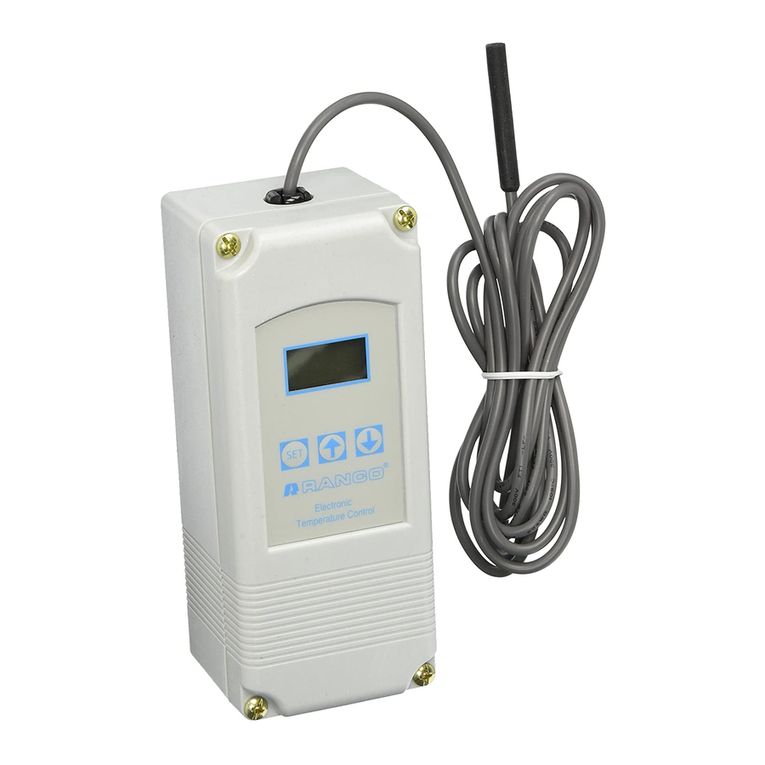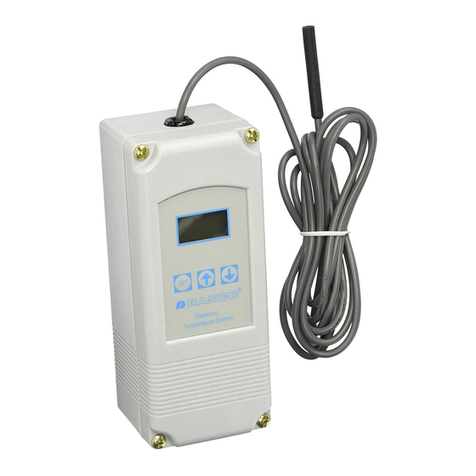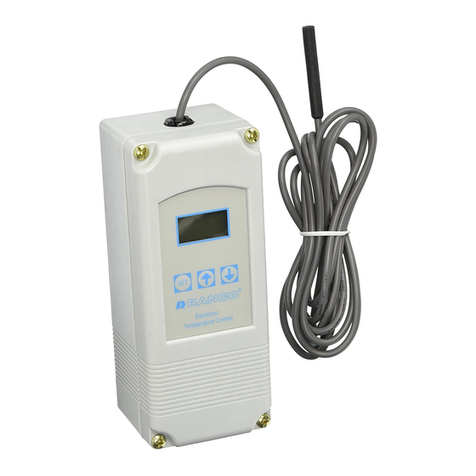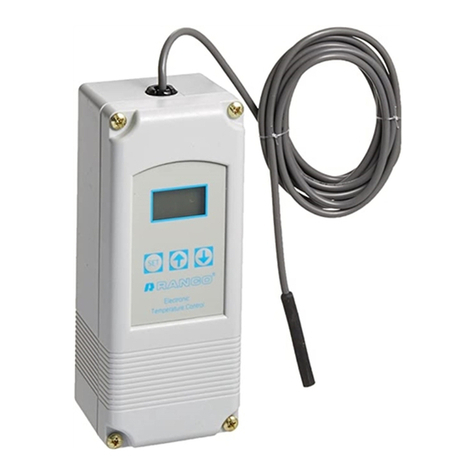
Form
No.
7515004-001
Rev.
B
ETC TWO STAGE ELECTRONIC TEMPERATURE CONTROL
PRODUCT DESCRIPTION RELAY ELECTRICAL RATINGS
120v 2081240V
The RancoETCisamicroprocessor-basedfamily NO Contact
of electronic temperature controls, designed to Full-loadamps 9.8
A
4.9 A
provideonloffcontrolforcommercialheating,cool- Lockedrotoramps 58.8 A 29.4
A
ing,airconditioningandrefrigeration.TheETCis Resistiveamps 9.8 A 4.9
A
equipped with a liquidcrystal display (LCD) that Horsepower 112 hp 112 hp
providesa constant readout of the sensed tem-
perature,andatouchkeypadthatallowsthe user NC Contact
to easilyand accuratelyselectthe set pointtem- Full-loadamps 5.8 A 2.9 A
perature,differentialandheating/coolingmodeof Lockedrotor amps 34.8
A
17.4 A
the operation. Modelsare availablethatoperate Resistiveamps 5.8
A
2.9 A
on either linevoltage Horsepower 114 hp 114 hp
(12012081240 VAC) or lowvoltage(24VAC). ilot Duty:
125
VA at 12012081240VAC
C
-
APPLICATIONS
With itswidetemperature
setpoint rangeandselectable
heatingor coolingmodes,the
FTCcanbe usedfor awide variety of
ControlAmbient Temperature
Operating -20°F to 140T(%!VRht&~°C)
Storage -40°F to176°F (-40°C to80°C)
Ambient Humidity 0 to 95%, RH, Non-condensing
0to 10VOutput Impedance 1
K
-
Enclosure NEMA 1. Plastic
I-
-
-
applications includingmultiple Agency Approvals ULListed, FileE94419,Guide XAPX
compressorcontrol,two stage heating, CSA Certified, FileLR68340, Class 4813 02
ventilationcontrol, automatic chaqw
ETC ORDERNG INFORMAT
-
--
space and returnairtemperature control,water cooled condensers
andcontrolwith alarm funtion.
FEATURES
r
Widesetpointtemperaturerange(-30°F to 220°F) and
differentialadjustment (1°F to 30°F).
r
Simple keypad programmingof setpointtemperature,
differentialandcoolingheatingmodes.
r
Two individuallyprogrammablestages for heating
andlorcooling.
r
LCD readoutof sensortemperature, controlsettings,
relaystatus andonboarddiagnostics.
Remotetemperature sensingup to 400feet.
r
Two SPDToutput relays.
r
User-selectable FahrenheitICelsiusscales.
r
Lockoutswitchto prevent tampering by unauthorized
personnel.
r
Choice of linevoltage and low voltagemodels available.
r
Optional0 to 10volt analogoutput availablefor remote
temperature indication.
SPECIFICATIONS
InputVoltage 120or 2081240 VAC (24VAC optional), 50160
Hz
Temperature Range -30°F to220°F
Input No. of 0-10V
Code Number Voltage Stages Output
ETC-211000-000 1201240 2 NO
ETC-211100-000 1201240 2 Yes
ETC-212000-000 24 2 NO
ETC-212100-000 24
2
Yes
OPERATION
Liquid Crystal Display(LCD)
The LCDdisplay providesa constantreadout of the sensor temperature
and indicatesif either of the two output relays isenergized. When the
S1
annunciator isconstantlyilluminatedduringoperation, the Stage 1 relay is
energized. Likewise,when the S2 annunciatorisconstantlyilluminated
duringoperation, the Stage2 relayisenergized. The display isalso used
inconjunctionwith the keypadto allowthe userto adjustthe setpoint
temperatures, differentialsand heatinglcoolingmodesfor each stage.
Control Setup
The temperaturesetpointrefersto the temperatureat which the normally
open
(NO)
contactsof the output relaywill open. Determinethe loadsto
be controlledandthe operatingmodes requiredfor each stage, coolingor
heating.
@Whenthe cooling mode ischosen, the differential isabove the setpoint.
The relaywill de-energizeasthe temperaturefalls tothe setpoint.
-
DifferentialRange 1OF to30°F
SPDT *When the heatingmode ischosen, the differential isbelow the setpoint.
Switch Action relaywill de-energizeas the temperature risesto the setpoint.
Sensor Thermistor, 1.94in. long
x
0.25 in. dia
8
ft.
cable The ETCtwo stage control can be set upfor two stages of heating,two stages
Power Consumption 12012081240VAC
:
100milliamps of coolingor one stage cooling plus one stage heating. Referto Figures 1,2
24VAC
:
2-6VAC and 3for avisual representationsof differentcontrolsetups.



























